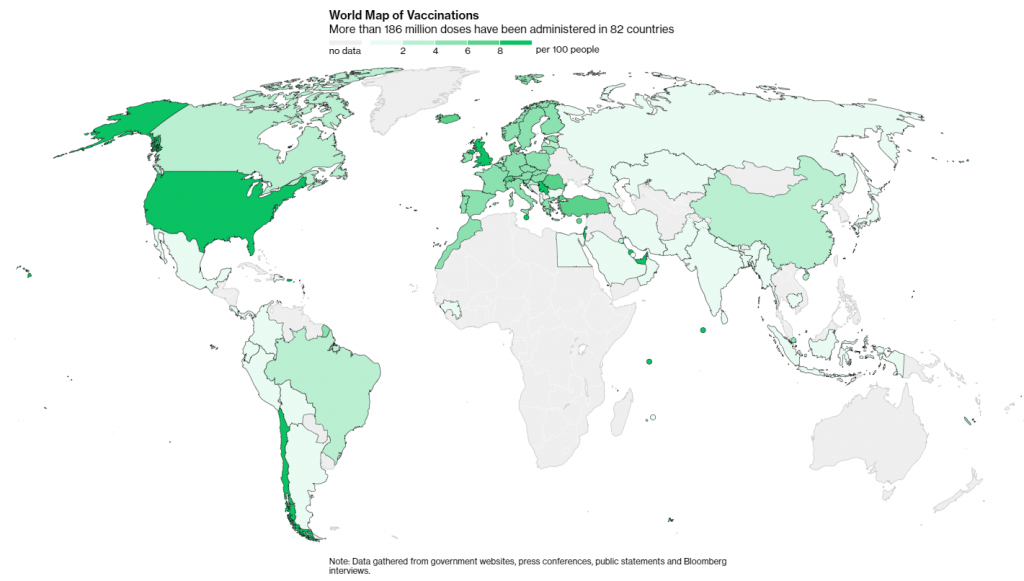The world is now into month three of COVID-19 vaccinations, with over 186 million doses administered worldwide, across 82 different countries, at a rate of 6.34 million doses per day at the current run-rate.
Unfortunately for Australians, we are not among those 82 nations, though our rollout of the Pfizer vaccination begins today, across most states and territories.
Today’s note will provide an update to the figures we believe you should be aware of, as well as addressing several of the health questions I’ve received lately.
Global efforts to stop COVID-19
First and foremost, the nations of the world are united in our mutual agreement to eradicate COVID-19’s influence on our lives.
There are several high-profile vaccines that have been developed to combat COVID, having been tested over months, approved and being used around the globe.
The most notable is Pfizer-BioNTech’s vaccine, which has been cleared for use across North America, Europe, the Middle East and Australia.
In fact, this is the vaccine that is beginning to be used today, in Australia.
Otherwise, Moderna’s vaccine is similar to Pfizer’s in that it has around 95% efficacy in reducing coronavirus infections, tested on tens of thousands of volunteers (largely front line workers).
AstraZeneca also has a widely authorised vaccine, which began to be rolled out in the UK on December 30th 2020, though has a lower efficacy (70-80%).
Pathway to immunity
Globally, the latest vaccination rate of 6.4 million doses per day indicates that it will take 4.9 years to cover 75% of the current population, with a two-dose vaccine.
This is an untenable situation and will need to be quickly addressed, as the virus is already beginning to mutate, and mutations may render existing vaccinations less effective or ineffective.
Hence, it’s in everyone’s best interest for effective vaccines to be administered quickly, to achieve herd immunity and make COVID-19 a thing of the past.
We do need to be aware, however, that mutations will likely occur over time and subsequent inoculations may be required in the future.

Greatest logistical challenge of all time
Countries are already experiencing unequal access to vaccines and varying degrees of efficiency in administering shots to their populations.
Australia epitomises this struggle, where we do not possess the required technology to produce the Pfizer or Moderna vaccinations domestically and rely on importing the doses.
This puts us at a disadvantage to nations that can self-supply these vaccines, after requiring the rights to do so.
This is one of the main reasons why Israel is the gold standard for the rate of inoculation, administering ~76 doses for every 100 persons in the country, when most other nations have barely started (or not at all). Israel’s vaccination story is quite an interesting one, with a good summary provided in this Atlantic article.
Delivering billions of these vaccinations globally to stop the spread and mutation of COVID19 will be incredibly difficult and require more and more production power.

Vaccine variants
There are many different vaccines being developed; Bloomberg tracks nine of the most promising, where seven of these nine are available in limited quantities across the 82 countries currently vaccinating.
These include:

On top of this supply, Australia also has access to the COVAX Facility, which gives us access to nine vaccine candidates, several which are still going through clinical trials.
These include:

Australia’s vaccine rollout phases
For those interested in the full rollout schedule, it is available on our Commonwealth health.gov.au website.
Below is our national rollout strategy and is unlikely to change drastically over the coming months/years.
In advance, remember that all the vaccinations we’ve pre-purchased require TWO jabs, and under this schedule, we should expect for the majority of Australians – working age population without serious medical issues to be vaccinated after May/June at the earliest, also assuming supply isn’t an issue.

If you fall within the Phase 1 category, then the government’s current strategy is to let selected persons know via phone call, email or text message, so that their vaccination date and time can be arranged.
States and territories are receiving 50k doses initially, with the government distributing 30k for aged care staff and residents, while setting aside 62k doses for second vaccinations.
As this will affect us all, it is worth finding out your own location for the vaccine to be administered.
For example, NSW Health has publicised the NSW locations, though I can’t yet find them on the NSW Health website – thankfully ABC and SMH have shared this:

Closing remarks
This topic will be of concern and interest for the foreseeable future, and we’ll continually provide updates with keen interest to the vaccination rollout and its impact to economic data and investment opportunities.
The views expressed in this article are the views of the stated author as at the date published and are subject to change based on markets and other conditions. Past performance is not a reliable indicator of future performance. Mason Stevens is only providing general advice in providing this information. You should consider this information, along with all your other investments and strategies when assessing the appropriateness of the information to your individual circumstances. Mason Stevens and its associates and their respective directors and other staff each declare that they may hold interests in securities and/or earn fees or other benefits from transactions arising as a result of information contained in this article.



